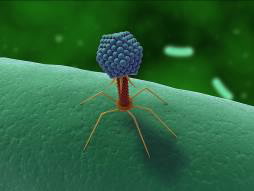FOR IMMEDIATE RELEASE
ACS News Service Weekly PressPac: May 08, 2013
Using 'bacteria-eaters' to prevent infections on medical implant materials
They’re ba-ack! But in a new disease-fighting role. Viruses that infect and kill bacteria — used to treat infections in the pre-antibiotic era a century ago and in the former Soviet Union today — may have a new role in preventing formation of the sticky “biofilms” of bacteria responsible for infections on implanted medical devices. That’s the topic of a report in the ACS journal Biomacromolecules.
Marek Urban and colleagues explain that bacteriophages (literally, “bacteria eaters”) were first used to treat bacterial infections in the 19th century. These viruses — more than 1,000 different kinds exist — attack disease-causing bacteria. The scientists focused on use of phages to wage “microbial warfare” on the films of bacteria that form on catheters, stents and other medical implants. These infections, which often involve antibiotic-resistant bacteria, strike more than a million patients annually in the United States alone, increasing hospital bills by almost $1 billion.
They describe attachment of phages to the surfaces of materials like those used in implanted medical devices, and evidence that the phages remain active, killing E. coli and Staphylococcus aureus. Those bacteria cause the most common hospital-acquired infections. The technology can attach phages to almost any surface, and is “a promising and effective means of not only combating antibiotic-resistant infections, but also the technological platform for the development of bacteria sensing and detecting devices.”
The authors acknowledge funding from the National Science Foundation; the Sirrine Foundation; and the Mississippi INBRE, which is funded by the National Institute of General Medical Sciences, National Institutes of Health.
![]()
Contact
Science Inquiries: Michael Woods, Editor, 202-872-6293
General Inquiries: Michael Bernstein, 202-872-6042

treat infections in the pre-antibiotic era a century
ago and in the former Soviet Union today — may
have a new role in preventing formation of the
sticky “biofilms” responsible for infections on
implanted medical devices.

